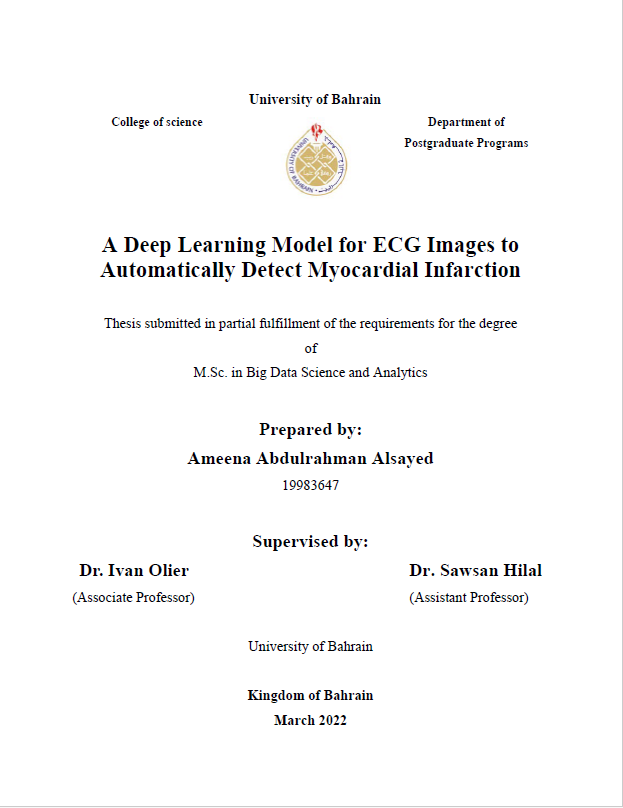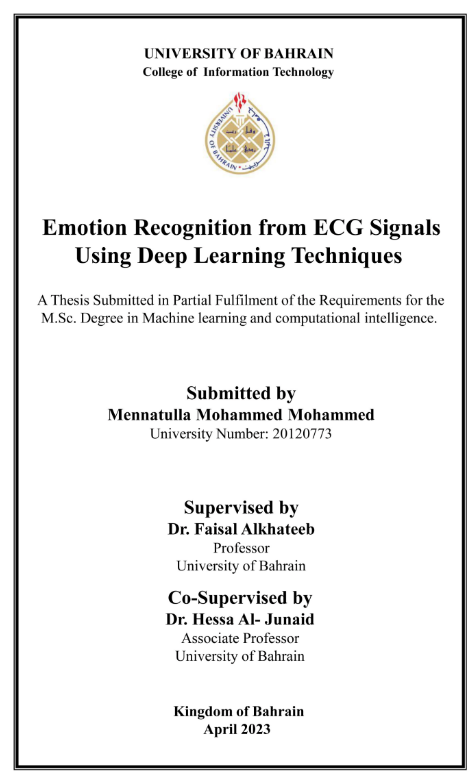An Incremental Deep Learning Approach for Pricing Prediction Strategy in the Insurance Industry
وكيل مرتبط
Ksantini, Interest of , مشرف الرسالة العلمية
Kaabi, Jihene , مشرف الرسالة العلمية
تاريخ النشر
2022
اللغة
الأنجليزية
مدى
[3], 9, 76, [6] pages
الموضوع
مكان المؤسسة
Sakhir, Bahrain
نوع الرسالة الجامعية
Thesis (Master)
الجهه المانحه
"""University of Bahrain, College of Science, Department of Postgraduate Programs
الملخص الإنجليزي
Abstract :
Deep learning is a type of machine learning known for its competitive advantage in discovering complex relationships in all data types. However, the insurance applications of deep learning were used for damage detection and churn prediction applications, while the premium prediction received low attention from previous researchers. This study aims to build an incremental deep leaming model to predict insurance premiums. The model contributes to the previously studied Usage-Based Insurance (UBI) concept.
This thesis proposes a deep learning model consistent with the UBI concept that considers the available factors affecting the premium to predict the insurance premium. The proposed model consists of two parts. Part one is the Convolutional Neural Network (CNN) for deep features extraction. Part two is the Support Vector Regression (SVR) built on the extracted deep features to predict the premium. The proposed model is called CNN-SVR after combining the two parts of CNN and SVR.
The dataset was collected from an insurance company to train the proposed model and evaluate its performance compared to the other classical models adopted previously by other researchers, namely the Neural Network (NN), Random Forests (RF), Decision Trees (DT), Linear Regression and Support Vector Regression (SVR).
The model performance evaluation was achieved using some metrics and the execution time needed to add a new data point to the model. The selected metrics are the Mean Squared Error (MSE), Root Mean Squared Error (RMSE), Mean Absolute Percentage of Error (MAPE), Explained Variance (EV), Correlation Coefficient (R), and t-test.
The proposed CNN-SVR model reported the best averages among the other models of 1363.935 MSE, 36.838 RMSE, 18.774 MAE, 11.940 ΜΑΡΕ, 0.957 R, and one minus P-Value values close to lin the t-test. The proposed incremental model reported a faster execution time than the classical models, which need to be retrained fally to add a new data point.
The study concluded that CNN-SVR model outperforms the other models in prediction performance and execution time, which supports the hypothesis. A possible future direction for this study is to use a larger dataset with more factors affecting the premium for a better contribution to the UBI and predictions.
Keywords: CNN, SVR, Deep Features, Prediction, Insurance, UBI, Incremental SVR,
Premium
الملخص العربي
الملخص :
في السنوات القليلة الماضية، تطورت تطبيقات التعلم الآلي بشكل كبير والتعلم العميق هو نوع من التعلم الآلي معروف بميزته التنافسية في اكتشاف العلاقات المعقدة في جميع أنواع البيانات. ومع ذلك، فقد تم استخدام تطبيقات التأمين الخاصة بالتعلم العميق للكشف عن الأضرار في السيارات وتطبيقات التنبؤ باحتمال خسارة العميل، بينما حظي التنبؤ بالأقساط باهتمام ضئيل من الباحثين السابقين. الهدف من هذه الدراسة هو بناء نموذج تعلم عميق متزايد للتنبؤ بأقساط التأمين. يساهم النموذج في المفهوم المدروس مسبقا للتأمين المستند إلى استخدام العميل الدراسة تتضمن مشكلة انحدار حيث المتغيرات المستقلة هي العوامل التي تؤثر على قسط التأمين.
تقترح هذه الورقة نموذجا تعليميا عميقا يتوافق مع مفهوم التأمين المستند إلى استخدام العميل الذي يأخذ في الاعتبار العوامل المتاحة التي تؤثر على قسط التأمين للتنبؤ بقسط التأمين. يتكون النموذج المقترح من جزأين، الجزء الأول هو الشبكة العصبية الالتفافية لاستخراج الميزات العميقة والجزء الثاني هو دعم الانحدار المتجه للتنبؤ بالقسط التأميني باستخدام الميزات العميقة. يشار إلى النموذج المقترح باسم CNN-SVR بعد الجمع بين الجزء الأول والثاني.
تم جمع عينة من مجموعة البيانات من شركة تأمين لتدريب النموذج المقترح وتقييم أدائه علاوة على ذلك، لتقييم أداء النموذج المقترح، تمت مقارنة النتائج بالنماذج الكلاسيكية الأخرى المستخدمة سابقا من قبل باحثين آخرين وهي الشبكة العصبية (NN) والغابات العشوائية (RF) وشجرة القرار (DT) والانحدار الخطي ودعم الانحدار المتجه (SVR) .
تم تقييم أداء النموذج باستخدام بعض المقاييس وبقياس وقت التنفيذ اللازم لإضافة نقطة بيانات جديدة إلى النموذج المقاييس المختارة هي متوسط الخطأ التربيعي (MSE) ، الخطأ التربيعي المتوسط الجذر (RMSE) ، متوسط النسبة المئوية المطلقة للخطأ ( MAPE) ، التباين الموضح (EV) ، معامل الارتباط(ي) ، واختبار القيمة ..
سجل النموذج المقترح أفضل المتوسطات بين النماذج الأخرى حيث سجل قيم 1363.935 MSE و 0.957 وكذلك سجل قيم قريبة من العدد MAPE 11.940 MAE 18.774 و RMSE 36.838 1 في اختبار القيمة .. أبلغ النموذج الإضافي المقترح عن وقت تنفيذ أسرع من النماذج الكلاسيكية التي تحتاج إلى إعادة التدريب بالكامل لإضافة نقطة بيانات جديدة.
ولخصت الدراسة إلى أن النموذج المقترح يتفوق على النماذج الأخرى في أداء التنبؤ ووقت التنفيذ مما يدعم الفرضية الموضوعة في البداية. يتمثل الاتجاه المستقبلي المحتمل لهذه الدراسة في استخدام مجموعة بيانات أكبر مع إضافة المزيد من العوامل التي تؤثر على القسط من أجل مساهمة أفضل في الفكرة التأمين المستند على الاستخدام وتنبؤات أدق.
في السنوات القليلة الماضية، تطورت تطبيقات التعلم الآلي بشكل كبير والتعلم العميق هو نوع من التعلم الآلي معروف بميزته التنافسية في اكتشاف العلاقات المعقدة في جميع أنواع البيانات. ومع ذلك، فقد تم استخدام تطبيقات التأمين الخاصة بالتعلم العميق للكشف عن الأضرار في السيارات وتطبيقات التنبؤ باحتمال خسارة العميل، بينما حظي التنبؤ بالأقساط باهتمام ضئيل من الباحثين السابقين. الهدف من هذه الدراسة هو بناء نموذج تعلم عميق متزايد للتنبؤ بأقساط التأمين. يساهم النموذج في المفهوم المدروس مسبقا للتأمين المستند إلى استخدام العميل الدراسة تتضمن مشكلة انحدار حيث المتغيرات المستقلة هي العوامل التي تؤثر على قسط التأمين.
تقترح هذه الورقة نموذجا تعليميا عميقا يتوافق مع مفهوم التأمين المستند إلى استخدام العميل الذي يأخذ في الاعتبار العوامل المتاحة التي تؤثر على قسط التأمين للتنبؤ بقسط التأمين. يتكون النموذج المقترح من جزأين، الجزء الأول هو الشبكة العصبية الالتفافية لاستخراج الميزات العميقة والجزء الثاني هو دعم الانحدار المتجه للتنبؤ بالقسط التأميني باستخدام الميزات العميقة. يشار إلى النموذج المقترح باسم CNN-SVR بعد الجمع بين الجزء الأول والثاني.
تم جمع عينة من مجموعة البيانات من شركة تأمين لتدريب النموذج المقترح وتقييم أدائه علاوة على ذلك، لتقييم أداء النموذج المقترح، تمت مقارنة النتائج بالنماذج الكلاسيكية الأخرى المستخدمة سابقا من قبل باحثين آخرين وهي الشبكة العصبية (NN) والغابات العشوائية (RF) وشجرة القرار (DT) والانحدار الخطي ودعم الانحدار المتجه (SVR) .
تم تقييم أداء النموذج باستخدام بعض المقاييس وبقياس وقت التنفيذ اللازم لإضافة نقطة بيانات جديدة إلى النموذج المقاييس المختارة هي متوسط الخطأ التربيعي (MSE) ، الخطأ التربيعي المتوسط الجذر (RMSE) ، متوسط النسبة المئوية المطلقة للخطأ ( MAPE) ، التباين الموضح (EV) ، معامل الارتباط(ي) ، واختبار القيمة ..
سجل النموذج المقترح أفضل المتوسطات بين النماذج الأخرى حيث سجل قيم 1363.935 MSE و 0.957 وكذلك سجل قيم قريبة من العدد MAPE 11.940 MAE 18.774 و RMSE 36.838 1 في اختبار القيمة .. أبلغ النموذج الإضافي المقترح عن وقت تنفيذ أسرع من النماذج الكلاسيكية التي تحتاج إلى إعادة التدريب بالكامل لإضافة نقطة بيانات جديدة.
ولخصت الدراسة إلى أن النموذج المقترح يتفوق على النماذج الأخرى في أداء التنبؤ ووقت التنفيذ مما يدعم الفرضية الموضوعة في البداية. يتمثل الاتجاه المستقبلي المحتمل لهذه الدراسة في استخدام مجموعة بيانات أكبر مع إضافة المزيد من العوامل التي تؤثر على القسط من أجل مساهمة أفضل في الفكرة التأمين المستند على الاستخدام وتنبؤات أدق.
ملاحظة
Tittle on cover :
استراتيجية للتنبؤ بالأسعار في قطاع التأمين باستخدام التعلم العميق التدريجي
استراتيجية للتنبؤ بالأسعار في قطاع التأمين باستخدام التعلم العميق التدريجي
المجموعة
المعرف
https://digitalrepository.uob.edu.bh/id/fa4c9336-e661-47d8-bab2-74f34f02ef4c
مواد أخرى لنفس الموضوع

